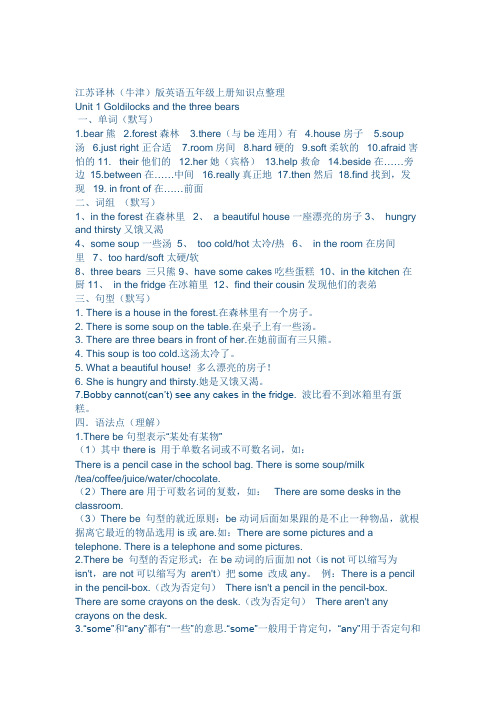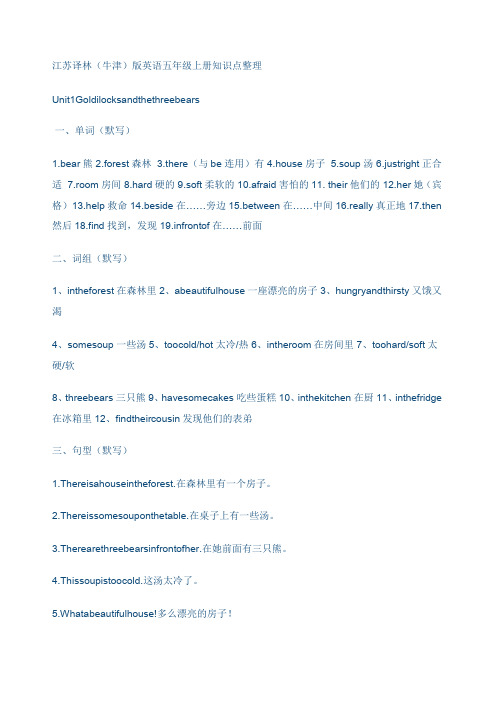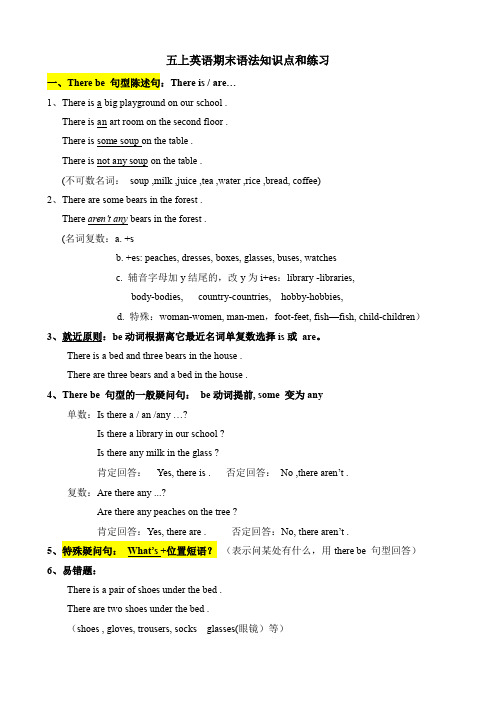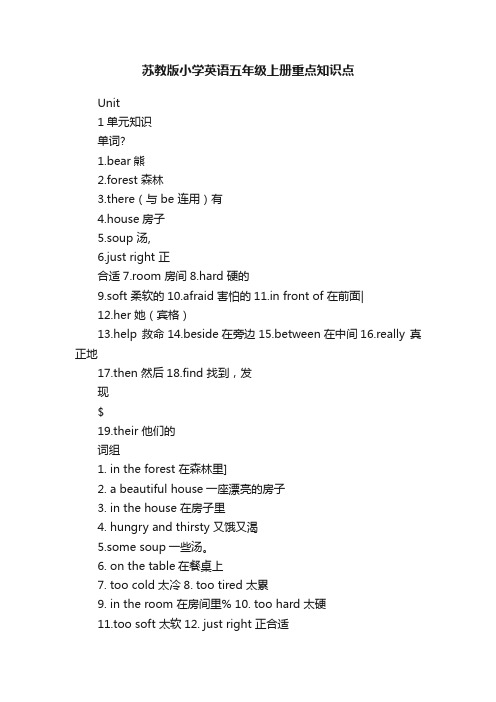苏教版五年级(上)英语语法
苏教版五年级上英语知识点大汇总(1)

江苏译林(牛津)版英语五年级上册知识点整理Unit 1 Goldilocks and the three bears一、单词(默写)1.bear熊2.forest森林3.there(与be连用)有4.house房子5.soup汤 6.just right正合适7.room房间8.hard硬的9.soft柔软的10.afraid害怕的11. their他们的12.her她(宾格)13.help救命14.beside在……旁边15.between在……中间16.really真正地17.then然后18.find找到,发现19. in front of在……前面二、词组(默写)1、in the forest在森林里2、a beautiful house一座漂亮的房子3、hungry and thirsty又饿又渴4、some soup一些汤5、too cold/hot太冷/热6、in the room在房间里7、too hard/soft太硬/软8、three bears 三只熊9、have some cakes吃些蛋糕10、in the kitchen在厨11、in the fridge在冰箱里12、find their cousin发现他们的表弟三、句型(默写)1. There is a house in the forest.在森林里有一个房子。
2. There is some soup on the table.在桌子上有一些汤。
3. There are three bears in front of her.在她前面有三只熊。
4. This soup is too cold.这汤太冷了。
5. What a beautiful house! 多么漂亮的房子!6. She is hungry and thirsty.她是又饿又渴。
7.Bobby cannot(can’t) see any cakes in the fridge. 波比看不到冰箱里有蛋糕。
苏教版五年级英语上册1-8单元知识点汇总

苏教版五年级英语上册1-8单元知识点汇总Unit 1 单元知识单词1.bear熊2.forest森林3.there(与be连用)有4.house房子5.soup汤6.just right正合适7.room房间8.hard硬的9.soft柔软的10.afraid害怕的11.in front of在……前面12.her她(宾格)13.help救命14.beside在……旁边15.between在……中间16.really真正地17.then然后18.find找到,发现19.their他们的词组1. in the forest在森林里2. a beautiful house一座漂亮的房子3. in the house 在房子里4. hungry and thirsty又饿又渴5.some soup一些汤6. on the table在餐桌上7. too cold太冷了8. too hot太热9. in the room在房间里10. too hard太硬11.too soft太软了12. just right正合适13. be afraid害怕14. three bears三只熊15. in front of her在她前面16. a glass of milk一杯牛奶17.have a cold得了感冒18.put on your coats穿上你们的外套19.in China在中国20.have some cakes吃些蛋糕21.in the kitchen在厨房里22.in the fridge在冰箱里23.between the windows and the door在窗户和门之间24.find their cousin找到他们的表弟句型1. There is a house in the forest.在森林里有一个房子。
2. There is some soup on the table.在桌子上有一些汤。
苏教版五年级上英语知识点大汇总

江苏译林(牛津)版英语五年级上册知识点整理Unit1Goldilocksandthethreebears一、单词(默写)1.bear熊2.forest森林3.there(与be连用)有4.house房子5.soup汤6.justright正合适7.room房间8.hard硬的9.soft柔软的 10.afraid害怕的11. their他们的 12.her她(宾格)13.help救命 14.beside在……旁边15.between在……中间 16.really真正地17.then 然后18.find找到,发现 19.infrontof在……前面二、词组(默写)1、intheforest在森林里2、abeautifulhouse一座漂亮的房子3、hungryandthirsty又饿又渴4、somesoup一些汤5、toocold/hot太冷/热6、intheroom在房间里7、toohard/soft太硬/软8、threebears三只熊9、havesomecakes吃些蛋糕10、inthekitchen在厨11、inthefridge 在冰箱里12、findtheircousin发现他们的表弟三、句型(默写)1.Thereisahouseintheforest.在森林里有一个房子。
2.Thereissomesouponthetable.在桌子上有一些汤。
3.Therearethreebearsinfrontofher.在她前面有三只熊。
4.Thissoupistoocold.这汤太冷了。
5.Whatabeautifulhouse!多么漂亮的房子!6.Sheishungryandthirsty.她是又饿又渴。
7.Bobbycanno t(can’t)seeanycakesinthefridge.波比看不到冰箱里有蛋糕。
四.语法点(理解)1.Therebe句型表示“某处有某物”(1)其中thereis用于单数名词或不可数名词,如:Thereisapencilcaseintheschoolbag.Thereissomesoup/milk/tea/coffee/juice/water/chocol ate.(2)Thereare用于可数名词的复数,如: Therearesomedesksintheclassroom.(3)Therebe句型的就近原则:be动词后面如果跟的是不止一种物品,就根据离它最近的物品选用is或are.如:Therearesomepicturesandatelephone.Thereisatelephoneandsomepictures.2.Therebe句型的否定形式:在be动词的后面加not(isnot可以缩写为isn't,arenot可以缩写为aren't)把some改成any。
新译林苏教版小学五年级上册语法总复习及练习

五年级语法总复习1.do/don’t/does/doesn’t + 动词原形。
2.can/can’t + 动词原形。
3.Let+宾格+动词原形。
4.want to do sth.想要做某事want to +动词原形5.like +动词ing . like +名词复数。
现在分词ing规则:6.be good at +宾格/名词/ 名词ing ①去不发音的e 加ing(skating,dancing,writing)7.be动词+动词ing ②只有一个元音,词尾只有一个辅音字母,8.行为动词go +动词ing 双写这个辅音字母加ing.(running,swimming)9.be动词有am, is, are. “我用am,你用are, is用于她他它。
单数is ,复数are.”10.“有”There is…/“有吗”Is there…? +可数名词单数/不可数名词。
There are /Are there+可数名词复数There be 句型就近原则11.an+ 以a o e i u 开头的单词前。
就近原则12.Play+球类。
play +the +乐器。
13.any”一些” 用于否定句和疑问句。
or”或者” 用于否定句和疑问句。
14.一般疑问句:be动词提前,情态动词提前,do/does提前(第三人称用does),第一人称变第二人称。
15.否定句:be动词(am is are)+not,情态动词can+ not,没有be动词和情态动词时用do, does +not(don’t, doesn’t)。
(第三人称用doesn’t)。
否定句第二种:名词前加no.16.主语(人/物)是第三人称单数时,陈述句中的动词+s/es, have变has。
否定句用doesn’t。
一般疑问句does提前。
第三人称单数有:he, she, it,一个物体,一个动物,一个人名,一个人称(father,mother, sister, brother, teacher, grandpa, uncle ,…)17.+es规则: ①单词以s, x, ch, sh,o结尾+es;②单词以辅音字母+y结尾,变y为i+es(hobbies, studies ,bodies,)18.特殊疑问句=特殊疑问词+一般疑问句。
苏教版译林英语五年级上册语法知识总结

五上英语期末语法知识点和练习一、There be 句型陈述句:There is / are…1、There is a big playground on our school .There is an art room on the second floor .There is some soup on the table .There is not any soup on the table .(不可数名词:soup ,milk ,juice ,tea ,water ,rice ,bread, coffee)2、There are some bears in the forest .There aren’t any bears in the forest .(名词复数:a. +sb. +es: peaches, dresses, boxes, glasses, buses, watchesc. 辅音字母加y结尾的,改y为i+es:library -libraries,body-bodies, country-countries, hobby-hobbies,d. 特殊:woman-women, man-men,foot-feet, fish—fish, child-children)3、就近原则:be动词根据离它最近名词单复数选择is或are。
There is a bed and three bears in the house .There are three bears and a bed in the house .4、There be 句型的一般疑问句:be动词提前, some 变为any单数:Is there a / an /any …?Is there a library in our school ?Is there any milk in the glass ?肯定回答:Yes, there is . 否定回答:No ,there aren’t .复数:Are there any ...?Are there any peaches on the tree ?肯定回答:Yes, there are . 否定回答:No, there aren’t .5(表示问某处有什么,用there be 句型回答)6、易错题:There is a pair of shoes under the bed .There are two shoes under the bed .(shoes , gloves, trousers, socks glasses(眼镜)等)7、某处没有什么,用no 和not表达不同:There is no egg in the fridge. There is not an egg in the fridge.There are no apples on the table. There are not any apples on the table.二、How many 句型用法:How many + 可数名词的复数,分两种情况:1、什么地方有多少什么?How many students are there in our classroom ?回答:There are forty –four students in our classroom .(注意:当答案为一个时用There is one.回答。
新苏教版五年级(上)英语语法知识汇总【2020年-2021年最新】

新苏教版五年级(上)英语语法知识汇总一、词类:1、名词: 这里强调两点:不可数名词都默认为单数;所以总是用is名词复数如何加后缀:各种不同情况变化方法例词一般情况直接加-s book-books bag-bags cat-cats bed-beds以s. x. sh. ch结尾加-esbus-buses box-boxes brush-brusheswatch-watchespeach—peaches glass--glasses以“辅音字母+y”结尾变y为i, 再加-es family-families study--studies以“f或fe”结尾变f或fe为v;再加-esknife-knives不规则名词复数man-men woman-women policeman-policemen policewoman-policewomen mouse-mice foot-feet child-children fish-fish Chinese-Chinese2、人称代词和物主代词人称代词物主代词单数复数单数复数主格宾格主格宾格形容词性形容词性第一人称I(我)me we(我们)us my(我的)our(我们的)第二人称you(你)you you(你们)you your(你的) your(你们的)第三人称he(他)him they(他/她/它们)themhis(他的)their(他/她/它们的)she(她)her her(她的)it(它)it it(它的)人称代词:有主格和宾格之分.一般动词前用主格;动词后用宾格.3、指示代词4、冠词有a、an、the.a和an的区别:an用于元音音素(一般就是元音字母a、e、i、o、u)前;a用于辅音音素前.二、否定句:be动词(am、is、are)+not、情态动词can+ not、助动词(do、does)+ not如何将一个肯定的陈述句改为否定句:1、看句中有无be动词;如有;直接在be动词后+ not.2、看句中有无情态动词;如有;直接在情态动词后+ not.3、如上述二者都没有;就应用助动词+ not.分四个步骤:?肯定陈述句中本来是没有助动词的;要加上去;位置在主语(某人或某物)后;动词前?确定助动词用do、does;根据句中动词;动词是原形的助动词就用do;动词是第三人称单数的助动词就用does;?在助动词后加not.?原句中动词假如发生变化就要恢复成原形.强调一点;有some的要考虑是否要用any.三、一般疑问句.如何将一个肯定的陈述句改为一般疑问句:1、看句中有无be动词;如有;把be动词提到句首即可.2、看句中有无情态动词;如有;把情态动词提到句首即可.3、如上述二者都没有;就应把助动提到句首.分四个步骤:?肯定陈述句中本来是没有助动词的;要加上去;位置在主语(某人或某物)后;动词前.?确定助动词用do还是does;根据句中动词;动词是原形的助动词就用do;动词是第三人称单数的助动词就用does?把助动词后提到句首.?原句中动词假如发生变化就要恢复成原形.强调一点;有some的要考虑是否要用any.四、特殊疑问句.表示疑问;有疑问词(在开头);回答有很多种可能.常用疑问词:五、时态1、一般现在时:一般现在时中的be动词:一般用原形:am is are①am用于第一人称单数(I);②is用于第三人称单数(he she it和其他人名或称谓;如:Ben his sister等);③are用于第二人称单数(you)和所有复数(包括第一人称复数we、第二人称复数you;第三人称复数they和其他复数;如the children 、his parents等).一般现在时中的动词:第一种情况:主语是第三人称单数(he she it 和其他;如Helen 、her cousin等);动词后一般加s或es.第二种情况:主语不是第三人称单数;动词都用原形.一般现在时判断依据(如何判断一个句子是一般现在时):△be动词是am、is、are △动词用原形或加s、es△没有时间状语或有usually、often、everyday、sometimes等不是具体的时间2、现在进行时(1)构成形式:Be动词+动词的ing形式这里强调一点;两者缺少其中任何一种都不可以构成现在进行时.(2)现在进行时表示动作正在进行或事情正在发生.(3)有用的依据:一个句子中既有be动词;又有动词;且动词加了ing ←→ 该句是现在进行时(4)句中往往有now、look、listen等词.动词现在分词的变化见下表:同音词:too---two----to ;buy---by ;I---eye;four----forthere----their ;right----write ;sun----son ;no----knowhere---hear ;who’s----whose近义词:many---a lot of 或者lots of;large----big ;desk----table;photo---picture;lamp----light;like----love;ill---sick反义词或对应词:old----new ;;big----small;open----close;black----white;here----there 完整形式:let’s=let us(让我们) I’d=I would can’t=can not I’m=I am词性变换:one(序数词) first monkey(复数)monkeys skiing(原形)skiis(复数)are families(单数)family make(现在分词)makingwe are(缩略形式)we’re do(第三人称单数)does have(第三人称单数)hasphoto(复数)photos fat(反义词)thin★做题目时一定要记住:1.can+动词原形2.like+动词ing3.like+名词复数4.play+足球类play the +乐器类5.how many +名词复数6.would like +to+动词原形;want+to+动词原形7.let's+动词原形8.现在进行时:be(am,is,are)+动词ing9.动词第三人称单数形式。
苏教版五年级(上)英语语法知识汇总

苏教版五年级(上)英语语法知识汇总一、词类:1、名词: 这里强调两点:不可数名词都默认为单数,所以总是用is名词复数如何加后缀:2、人称代词和物主代词人称代词:有主格和宾格之分。
一般动词前用主格,动词后用宾格。
3、指示代词4、冠词有a、an、the。
a和an的区别:an用于元音音素(一般就是元音字母a、e、i、o、u)前,a用于辅音音素前。
二、否定句:●be动词(am、is、are)+not、●情态动词can+ not、●助动词(do、does)+ not如何将一个肯定的陈述句改为否定句:1、看句中有无be动词,如有,直接在be动词后+ not。
2、看句中有无情态动词,如有,直接在情态动词后+ not。
3、如上述二者都没有,就应用助动词+ not。
分四个步骤:➢肯定陈述句中本来是没有助动词的,要加上去,位置在主语(某人或某物)后,动词前➢确定助动词用do、does,根据句中动词,动词是原形的助动词就用do,动词是第三人称单数的助动词就用does,➢在助动词后加not。
➢原句中动词假如发生变化就要恢复成原形。
强调一点,有some的要考虑是否要用any。
三、一般疑问句。
如何将一个肯定的陈述句改为一般疑问句:1、看句中有无be动词,如有,把be动词提到句首即可。
2、看句中有无情态动词,如有,把情态动词提到句首即可。
3、如上述二者都没有,就应把助动提到句首。
分四个步骤:➢肯定陈述句中本来是没有助动词的,要加上去,位置在主语(某人或某物)后,动词前。
➢确定助动词用do还是does,根据句中动词,动词是原形的助动词就用do,动词是第三人称单数的助动词就用does➢把助动词后提到句首。
➢原句中动词假如发生变化就要恢复成原形。
强调一点,有some的要考虑是否要用any。
四、特殊疑问句。
表示疑问,有疑问词(在开头),回答有很多种可能。
常用疑问词:五、时态1、一般现在时:●一般现在时中的be动词:一般用原形:am is are①am用于第一人称单数(I);②is用于第三人称单数(he she it和其他人名或称谓,如:Ben his sister等);③are用于第二人称单数(you)和所有复数(包括第一人称复数we、第二人称复数you;第三人称复数they和其他复数,如the children 、his parents等)。
苏教版五年级(上)英语语法知识汇总【2020年-2021年最新】

苏教版五年级(上)英语语法知识汇总一、词类:1、名词: 这里强调两点:不可数名词都默认为单数;所以总是用is名词复数如何加后缀:各种不同情况变化方法例词一般情况直接加-s book-books bag-bags cat-cats bed-beds以s. x. sh. ch结尾加-esbus-buses box-boxes brush-brushes watch-watchespeach—peaches glass--glasses以“辅音字母+y”结尾变y为i, 再加-es family-families study--studies以“f或fe”结尾变f或fe为v;再加-esknife-knives不规则名词复数man-men woman-women policeman-policemen policewoman-policewomen mouse-mice foot-feet child-children fish-fish Chinese-Chinese2、人称代词和物主代词人称代词物主代词单数复数单数复数主格宾格主格宾格形容词性形容词性第一人称I(我)me we(我们)us my(我的)our(我们的)第二人称you(你)you you(你们)you your(你的) your(你们的)第三人称he(他)him they(他/她/它们)themhis(他的)their(他/她/它们的)she(她)her her(她的)it(它)it it(它的)人称代词:有主格和宾格之分.一般动词前用主格;动词后用宾格.3、指示代词4、冠词有a、an、the.a和an的区别:an用于元音音素(一般就是元音字母a、e、i、o、u)前;a用于辅音音素前.二、否定句:be动词(am、is、are)+not、情态动词can+ not、助动词(do、does)+ not如何将一个肯定的陈述句改为否定句:1、看句中有无be动词;如有;直接在be动词后+ not.2、看句中有无情态动词;如有;直接在情态动词后+ not.3、如上述二者都没有;就应用助动词+ not.分四个步骤:?肯定陈述句中本来是没有助动词的;要加上去;位置在主语(某人或某物)后;动词前?确定助动词用do、does;根据句中动词;动词是原形的助动词就用do;动词是第三人称单数的助动词就用does;?在助动词后加not.?原句中动词假如发生变化就要恢复成原形.强调一点;有some的要考虑是否要用any.三、一般疑问句.如何将一个肯定的陈述句改为一般疑问句:1、看句中有无be动词;如有;把be动词提到句首即可.2、看句中有无情态动词;如有;把情态动词提到句首即可.3、如上述二者都没有;就应把助动提到句首.分四个步骤:?肯定陈述句中本来是没有助动词的;要加上去;位置在主语(某人或某物)后;动词前.?确定助动词用do还是does;根据句中动词;动词是原形的助动词就用do;动词是第三人称单数的助动词就用does?把助动词后提到句首.?原句中动词假如发生变化就要恢复成原形.强调一点;有some的要考虑是否要用any.四、特殊疑问句.表示疑问;有疑问词(在开头);回答有很多种可能.常用疑问词:五、时态1、一般现在时:一般现在时中的be动词:一般用原形:am is are①am用于第一人称单数(I);②is用于第三人称单数(he she it和其他人名或称谓;如:Ben his sister等);③are用于第二人称单数(you)和所有复数(包括第一人称复数we、第二人称复数you;第三人称复数they和其他复数;如the children 、his parents等).一般现在时中的动词:第一种情况:主语是第三人称单数(he she it 和其他;如Helen 、her cousin等);动词后一般加s或es.第二种情况:主语不是第三人称单数;动词都用原形.一般现在时判断依据(如何判断一个句子是一般现在时):△be动词是am、is、are △动词用原形或加s、es△没有时间状语或有usually、often、everyday、sometimes等不是具体的时间2、现在进行时(1)构成形式:Be动词+动词的ing形式这里强调一点;两者缺少其中任何一种都不可以构成现在进行时.(2)现在进行时表示动作正在进行或事情正在发生.(3)有用的依据:一个句子中既有be动词;又有动词;且动词加了ing ←→ 该句是现在进行时(4)句中往往有now、look、listen等词.动词现在分词的变化见下表:同音词:too---two----to ;buy---by ;I---eye;four----forthere----their ;right----write ;sun----son ;no----knowhere---hear ;who’s----whose近义词:many---a lot of 或者lots of;large----big ;desk----table;photo---picture;lamp----light;like----love;ill---sick反义词或对应词:old----new ;;big----small;open----close;black----white;here----there完整形式:let’s=let us(让我们) I’d=I would can’t=can not I’m=I am词性变换:one(序数词) first monkey(复数)monkeys skiing(原形)skiis(复数)are families(单数)family make(现在分词)makingwe are(缩略形式)we’re do(第三人称单数)does have(第三人称单数)hasphoto(复数)photos fat(反义词)thin★做题目时一定要记住:1.can+动词原形2.like+动词ing3.like+名词复数4.play+足球类play the +乐器类5.how many +名词复数6.would like +to+动词原形;want+to+动词原形7.let's+动词原形8.现在进行时:be(am,is,are)+动词ing9.动词第三人称单数形式10.11.12.13.。
苏教版小学英语五年级上册知识点

苏教版小学英语五年级上册知识点U n i t1G o l d i l o c k s a n d t h e t h r e e b e a r s一、单词(默写)熊森林(与b e连用)有房子汤r i g h t正合适房间硬的柔软的害怕的11.t h e i r他们的她(宾格)救命在……旁边在……中间真正地然后找到,发现19.i n f r o n t o f在……前面二、词组(默写)1、i n t h e f o r e s t在森林里2、a b e a u t i f u l h o u s e一座漂亮的房子3、h u n g r y a n d t h i r s t y又饿又渴?4、s o m e s o u p一些汤5、t o o c o l d/h o t太冷/热6、i n t h e r o o m在房间里7、t o o h a r d/s o f t太硬/软?8、t h r e e b e a r s三只熊9、h a v e s o m e c a k e s吃些蛋糕1 0、i n t h e k i t c h e n在厨11、i n t h e f r i d g e在冰箱里12、f i n d t h e i r c o u s i n发现他们的表弟三、句型(默写)1.T h e r e i s a h o u s e i n t h e f o r e s t.在森林里有一个房子。
?2.T h e r e i s s o m e s o u p o n t h e t a b l e.在桌子上有一些汤。
3.T h e r e a r e t h r e e b e a r s i n f r o n t o f h e r.在她前面有三只熊。
4.T h i s s o u p i s t o o c o l d.这汤太冷了。
?5.W h a t a b e a u t i f u l h o u s e!多么漂亮的房子!6.S h e i s h u n g r y a n d t h i r s t y.她是又饿又渴。
苏教版小学英语五年级[上册]知识点汇总
![苏教版小学英语五年级[上册]知识点汇总](https://img.taocdn.com/s3/m/12f9572869dc5022aaea009e.png)
苏教版小学英语五年级上册知识点U n i t1G o l d i l o c k s a n d t h e t h r e e b e a r s一、单词(默写)1.b e a r熊2.f o r e s t森林3.t h e r e(与b e连用)有4.h o u s e房子5. s o u p汤6.j u s t r i g h t正合适7.r o o m房间8.h a r d硬的9.s o f t柔软的10.a f r a i d害怕的11.t h e i r他们的12.h e r她(宾格)13.h e l p 救命14.b e s i d e在……旁边15.b e t w e e n在……中间16.r e a l l y真正地17.t h e n然后18.f i n d找到,发现19.i n f r o n t o f在……前面二、词组(默写)1、i n t h e f o r e s t在森林里2、a b e a u t i f u l h o u s e一座漂亮的房子3、h u n g r y a n d t h i r s t y又饿又渴4、s o m e s o u p一些汤5、t o o c o l d/h o t太冷/热6、i n t h e r o o m在房间里7、t o o h a r d/s o f t太硬/软8、t h r e e b e a r s三只熊9、h a v e s o m e c a k e s吃些蛋糕10、i n t h e ki t c h e n在厨11、i n t h e f r i d g e在冰箱里12、f i n d t h e i r c o u s i n发现他们的表弟三、句型(默写)1.T h e r e i s a h o u s e i n t h e f o r e s t.在森林里有一个房子。
2.T h e r e i s s o m e s o u p o n t h e t a b l e.在桌子上有一些汤。
苏教版小学五年级英语语法(完整资料).doc

【最新整理,下载后即可编辑】五年级英语语法知识汇总一、词类:1、名词这里强调两点:不可数名词都默认为单数,所以总是用is 名词复数如何加后缀:3、指示代词有a、an、the。
a和an的区别:an用于元音音素(一般就是元音字母a、e、i、o、u)前,a用于辅音音素前。
二、否定句:be动词(am、is、are)+not、情态动词can+ not、助动词(do、does)+ not如何将一个肯定的陈述句改为否定句:1、看句中有无be动词,如有,直接在be动词后+ not。
2、看句中有无情态动词,如有,直接在情态动词后+ not。
3、如上述二者都没有,就应用助动词+ not。
分四个步骤:(1)肯定陈述句中本来是没有助动词的,要加上去,位置在主语(某人或某物)后,动词前。
(2)确定助动词用do、does,根据句中动词,动词是原形的助动词就用do,动词是第三人称单数的助动词就用does,(3)在助动词后加not。
(4)原句中动词假如发生变化就要恢复成原形。
强调一点,有some的要考虑是否要用any。
三、一般疑问句。
如何将一个肯定的陈述句改为一般疑问句:1、看句中有无be动词,如有,把be动词提到句首即可。
2、看句中有无情态动词,如有,把情态动词提到句首即可。
3、如上述二者都没有,就应把助动提到句首。
分四个步骤:(1)肯定陈述句中本来是没有助动词的,要加上去,位置在主语(某人或某物)后,动词前。
(2)确定助动词用do还是does,根据句中动词,动词是原形的助动词就用do,动词是第三人称单数的助动词就用does(3)把助动词后提到句首。
(4)原句中动词假如发生变化就要恢复成原形。
强调一点,有some的要考虑是否要用any。
四、特殊疑问句。
表示疑问,有疑问词(在开头),回答有很多种可能。
常用疑问词:五、时态1、一般现在时(1)一般现在时中的be动词:一般用原形:am is aream用于第一人称单数(I);is用于第三人称单数(he she it和其他人名或称谓,如:Ben his sister等);are用于第二人称单数(you)和所有复数(包括第一人称复数we、第二人称复数you;第三人称复数they和其他复数,如the children 、his parents等)。
苏教版五年级上英语语法

苏教版五年级(上)英语语法一.语法点(理解)1.There be句型表示“某处有某物”(1)其中there is 用于单数名词或不可数名词,如:There is a pencil case in the school bag. There is some soup/milk /tea/coffee/juice/water/chocolate.(2)There are用于可数名词的复数,如:There are some desks in the classroom.(3)There be 句型的就近原则:be动词后面如果跟的是不止一种物品,就根据离它最近的物品选用is或are.如:There are some pictures and a telephone. There is a telephone and some pictures.2.There be 句型的否定形式:在be动词的后面加not(is not可以缩写为isn't,are not可以缩写为aren't)把some 改成any。
例:There is a pencil in the pencil-box.(改为否定句)There isn't a pencil in the pencil-box.There are some crayons on the desk.(改为否定句)There aren't any crayons on the desk.3.“some”和“any”都有“一些”的意思.“some”一般用于肯定句,“any”用于否定句和一般疑问句。
但在一些表示委婉请求,想得到对方肯定回答的疑问句中,也用“some”.例:1.There are some watermelons in the basket.(肯定句)2.There aren't any birds in the tree.(否定句)3.Are there any toy trains on the table?(疑问句) 4.Would you like some tea?(表委婉请求)4.can在否定句中的用法:表示某人不能做某事时,通常在can后面加否定词not, 后面加动词原形。
苏教版小学英语五年级上册重点知识点

苏教版小学英语五年级上册重点知识点Unit1单元知识单词?1.bear熊2.forest 森林3.there(与 be 连用)有4.house房子5.soup 汤,6.just right 正合适7.room 房间8.hard 硬的9.soft 柔软的10.afraid 害怕的11.in front of 在前面|12.her 她(宾格)13.help 救命14.beside在旁边15.between在中间16.really 真正地17.then 然后18.find 找到,发现$19.their 他们的词组1. in the forest 在森林里]2. a beautiful house一座漂亮的房子3. in the house 在房子里4. hungry and thirsty 又饿又渴5.some soup一些汤。
6. on the table在餐桌上7. too cold 太冷8. too tired 太累9. in the room 在房间里% 10. too hard 太硬11.too soft 太软12. just right 正合适13. be afraid 害怕< 14. three bears三只熊15. in front of her 在她前面16. a glass of milk 一杯牛奶17.have a cold得了感冒18.put on your coats穿上你们的外套、19.in China 在中国20.have some cakes吃些蛋糕21.in the kitchen 在厨房里22.in the fridge 在冰箱里23.between the windows and the door在窗户和门之间'24.find their cousin 找到他们的表弟25.three bowls of soup 三碗汤/doc/ee1699088.html,e and say 过来说27.in the glass 在玻璃杯中28.in Western countries 在西方国家【29.in the living room 在客厅里句型1.There is a house in the forest在.森林里有一个房子。
- 1、下载文档前请自行甄别文档内容的完整性,平台不提供额外的编辑、内容补充、找答案等附加服务。
- 2、"仅部分预览"的文档,不可在线预览部分如存在完整性等问题,可反馈申请退款(可完整预览的文档不适用该条件!)。
- 3、如文档侵犯您的权益,请联系客服反馈,我们会尽快为您处理(人工客服工作时间:9:00-18:30)。
一.语法点(理解)
1.There be句型表示“某处有某物”
(1)其中there is 用于单数名词或不可数名词,如:
There is a pencil case in the school bag. There is some soup/milk /tea/coffee/juice/water/chocolate.
(2)There are用于可数名词的复数,如:There are some desks in the classroom.
(3)There be 句型的就近原则:be
动词后面如果跟的是不止一种物品,就根据离它最近的物品选用is或are.如:There are some pictures and a telephone. There is a telephone and some pictures.
2.There be 句型的否定形式:在be动词的后面加not(is not可以缩写为isn't,are not可以缩写为aren't)把some 改成any。
例:There is a pencil in the pencil-box.(改为否定句)There isn't a pencil in the pencil-box.
There are some crayons on the desk.(改为否定句)There aren't any crayons on the desk.
3.“some”和“any”都有“一些”的意思.“some”一般用于肯定句,“any”用于否定句和一般疑问句。
但在一些表示委婉请求,想得到对方肯定回答的疑问句中,也用“some”.
例:1.There are some watermelons in the basket.(肯定句)
2.There aren't any birds in the tree.(否定句)
3.Are there any toy trains on the table?(疑问句
) 4.Would you like some tea?(表委婉请求)
4.can在否定句中的用法:表示某人不能做某事时,通常在can后面加否定词not, 后面加动词原形。
Bobby cannot(can’t) see any cakes in the fridge.
5. 感叹句的结构:感叹句常用how或what来引导
(1)what引导的感叹句
a.What+a/an+形容词+可数名词单数!What a beautiful house!
b.What+形容词+可数名词复数!What nice dresses!
c. What+形容词+不可数名词!What delicious milk!
(2)how引导的感叹句How+形容词/副词!How nice!
二.四、语法点(理解)
1.How many...(可数名词复数) are there...? 用于询问某处有多少...
例:
How many classrooms are there in our school? 2.There be 的一般疑问句,是将be动词提前到there的前面,表示“有......?”
(1)Is there...? Yes, there is ./ No, there isn’t . 例:Is there a music room ?
(2)Are there any...? Yes, there are./ No, there aren’t. 例:Are there any books?
3.几个缩写isn’t = is not aren’t= are not it’s = it is they’re= they are
4.序数词
one ----- first two --- second three---- third four---fourth five---fifth six---sixth
5.在楼层前用介词on , on the first /second/ third floor 在一/二/三楼...
三、语法have / has 的用法
1、表示某人有某物。
2、主语是第一、第二人称单数和复数时用have, 如I,you, we, they, the students …
主语是第三人称单数时用has, 如he, she, it, Helen, the bird, my father …
3、肯定句:…have / has …
We have a PE lesson on Monday morning. / It has a long tail. 否定句:…don’t / doesn’t +have …
They don’t have animal friends. / She doesn’t have a dog.
一般疑问句:Do / Does …have …Yes, …do / does. No, …don’t / don’t.
Do you have a f ootball? Yes, I do. / No, I don’t.
Does he have a toy car? Yes, he does. / No, he doesn’t.
四、语法
1. 询问别人喜欢干某事,What do/ does …like doing ?
喜欢干某事like doing sth, doing
表示喜欢经常做一件事。
主语是第三人称单数时注意like后面加s.
不喜欢干某事don’t/ doesn’t like doing sth
2.动名词的变化规律:
a. 一般情况下在动词后面加ing. 如going, reading, drawing, playing…
b. 以不发音的字母e结尾的动词,去e再加ing. 如dancing, making…
c. 以“元音+辅音”结尾的重读闭音节单词,先双写辅音字母再加ing. 如swimming, running, getting, putting…
五【语法知识】
1. 如何询问他人的职业
1)What does + 某人(your father, David...)do ? He / She is a / an +职业(farmer, teacher, doctor...)
例如:What does your father do? He is a doctor. 你爸爸做什么的?他是一个医生。
还可以这么问他人的职业:
2)What is + 某人?What is your father? 你爸爸做什么的?
3)What’s somebody’s job? What’s your father’s job? 你爸爸做什么的?
2. 询问“你”的职业
1) What’s your job? 你是做什么的?I am an English teacher. 我是一个英语老师。
2)What do you do? 你是做什么的I am a worker. 我是一名工人。
动词在第三人称单数形式的变化规则
规则例词
一般情况下,直接在动词的词尾加-s。
run - runs look - looks see -sees say -says
以-s, -sh, -ch, -x, -o结尾的动词,一般在词尾加-es. teach-teaches go-goes fix-fixes wash-washes
pass-passes
以辅音字母加y结尾的动词,先边y为i, 再加-es. study-studies try- tries
以元音字母加y结尾的动词,直接在词尾加-s。
play-plays stay-stays
注意:go(三单)——goes have(三单)——has
六语法
1. Does he / she …? 一般疑问句句中没有be动词,变为一般疑问句要借助助动词do / does。
助动词形态由主语的人称决定。
Does he / she …? 主语为第三人称单数,用does其结构为:Does +主语+谓语动词+其他?
2. What subjects does …like? 特殊疑问句这个句子用来询问他人喜欢什么科目的疑问句。
用于第三人称单数,在本句中用助动词does。
注意回答时like后面要加s。
七、语法:1.频率副词always , usually, often , sometimes ,按其频率高低排列为:always > usually > often > sometimes。
2. 询问某人在周末做什么的句型—What (do /does ) 主语do at weekends? 答句: 主语+动词原形/动词三单形式……
. ★do / does: 助动词,由主语的人称数而定. 主语是第三人称单数时,用does, 主语是第一人称、第二人称、第三人称复数时,用do.
★答句: 如果主语是第三人称单数,则要用动词三单形式;主语是第一人称、第二人称、第三人称复数时用动词原形。
